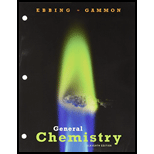
(a)
Interpretation:
The correct element and/or compound symbols, formulas, and coefficients needed to produce complete, balanced equation has to be given.
(a)
Answer to Problem 2.35QP
Explanation of Solution
The product in the given chemical equation is Lithium chloride. Hence, the starting material has to be Lithium and Chlorine.
To balance the chemical equation, coefficient 2 has to be added before
(b)
Interpretation:
The correct element and/or compound symbols, formulas, and coefficients needed to produce complete, balanced equation has to be given.
(b)
Answer to Problem 2.35QP
Explanation of Solution
The product in the given chemical equation is sodium sulfide. Hence, the starting material has to be Sodium and Sulfur.
To balance the chemical equation, coefficient 16 before sodium, and coefficient 8 has to be added before
(c)
Interpretation:
The correct element and/or compound symbols, formulas, and coefficients needed to produce complete, balanced equation has to be given.
(c)
Answer to Problem 2.35QP
Explanation of Solution
The product in the given chemical equation is aluminium iodide. Hence, the starting material has to be Aluminium and Iodine.
To balance the chemical equation, coefficient 3 before aluminium and iodine. Coefficient 2 has to be added before
(d)
Interpretation:
The correct element and/or compound symbols, formulas, and coefficients needed to produce complete, balanced equation has to be given.
(d)
Answer to Problem 2.35QP
Explanation of Solution
The product in the given chemical equation is Barium nitride. Hence, the starting material has to be Barium and Nitrogen.
To balance the chemical equation, coefficient 3 has to be added before barium. Hence, the equation can be written as,
(e)
Interpretation:
The correct element and/or compound symbols, formulas, and coefficients needed to produce complete, balanced equation has to be given.
(e)
Answer to Problem 2.35QP
Explanation of Solution
The product in the given chemical equation is
To balance the chemical equation, start balancing phosphorous first. In the product side coefficient 4 has to be added and in the reactant side, coefficient 5 has to be added before phosphorous. Hence, the equation can be written as,
Now start to balance vanadium. This is done by adding coefficient 12 before vanadium in the reactant side. The balanced equation can be written as,
Want to see more full solutions like this?
Chapter 2 Solutions
Bundle: General Chemistry, Loose-leaf Version, 11th + OWLv2 with Student Solutions Manual eBook, 4 terms (24 months) Printed Access Card
- Indicate the variation in conductivity with concentration in solutions of strong electrolytes and weak electrolytes.arrow_forwardThe molar conductivity of a very dilute solution of NaCl has been determined. If it is diluted to one-fourth of the initial concentration, qualitatively explain how the molar conductivity of the new solution will compare with the first.arrow_forwardWhat does the phrase mean, if instead of 1 Faraday of electricity, Q coulombs (Q/F Faradays) pass through?arrow_forward
- What characteristics should an interface that forms an electrode have?arrow_forwardFor a weak acid AcH, calculate the dissociated fraction (alpha), if its concentration is 1.540 mol L-1 and the concentration [H+] is 5.01x10-4 mol L-1.arrow_forwardIf the molar conductivity at infinite dilution of HAC is A0 = 390.5 S cm² mol¹. Calculate the Arrhenius conductivity of a 9.3% by weight solution of HAc with a pH of 3.3. Data: molecular weight of HAC is 60.05 g/mol and the density of the solution is 1 g/cm³.arrow_forward
- If the molar conductivity at infinite dilution of HAC is A0 = 390.5 S cm² mol¹. Calculate the Arrhenius conductivity of a 9.3% by weight solution of HAc with a pH of 3.3. Data: molecular weight of HAC is 60.05 g/mol and the density of the solution is 1 g/cm³.arrow_forwardIf the molar conductivity at infinite dilution of HAC is A0 = 390.5 S cm² mol¹. Calculate the Arrhenius conductivity of a 9.3% by weight solution of HAc with a pH of 3.3. Data: molecular weight of HAC is 60.05 g/mol and the density of the solution is 1 g/cm³.arrow_forwardDetermine the distance between the metal and the OHP layer using the Helm- holtz model when the electrode's differential capacitance is 145 μF cm². DATA: dielectric constant of the medium for the interfacial zone &r= lectric constant of the vacuum &0 = 8.85-10-12 F m-1 = 50, die-arrow_forward
- Describe a sequence of photophysical processes that can be followed by radiation adsorbed by a molecule in the ground state to give rise to phosphorescent emission.arrow_forwardState two similarities between fluorescence and phosphorescence.arrow_forwardState three photophysical processes that can be related to the effects of incident radiation on a molecule in its ground state. Consider that radiation can give rise to fluorescent emission, but not phosphorescent emission.arrow_forward
 Chemistry: The Molecular ScienceChemistryISBN:9781285199047Author:John W. Moore, Conrad L. StanitskiPublisher:Cengage Learning
Chemistry: The Molecular ScienceChemistryISBN:9781285199047Author:John W. Moore, Conrad L. StanitskiPublisher:Cengage Learning General Chemistry - Standalone book (MindTap Cour...ChemistryISBN:9781305580343Author:Steven D. Gammon, Ebbing, Darrell Ebbing, Steven D., Darrell; Gammon, Darrell Ebbing; Steven D. Gammon, Darrell D.; Gammon, Ebbing; Steven D. Gammon; DarrellPublisher:Cengage Learning
General Chemistry - Standalone book (MindTap Cour...ChemistryISBN:9781305580343Author:Steven D. Gammon, Ebbing, Darrell Ebbing, Steven D., Darrell; Gammon, Darrell Ebbing; Steven D. Gammon, Darrell D.; Gammon, Ebbing; Steven D. Gammon; DarrellPublisher:Cengage Learning World of Chemistry, 3rd editionChemistryISBN:9781133109655Author:Steven S. Zumdahl, Susan L. Zumdahl, Donald J. DeCostePublisher:Brooks / Cole / Cengage Learning
World of Chemistry, 3rd editionChemistryISBN:9781133109655Author:Steven S. Zumdahl, Susan L. Zumdahl, Donald J. DeCostePublisher:Brooks / Cole / Cengage Learning Introductory Chemistry: A FoundationChemistryISBN:9781337399425Author:Steven S. Zumdahl, Donald J. DeCostePublisher:Cengage Learning
Introductory Chemistry: A FoundationChemistryISBN:9781337399425Author:Steven S. Zumdahl, Donald J. DeCostePublisher:Cengage Learning General, Organic, and Biological ChemistryChemistryISBN:9781285853918Author:H. Stephen StokerPublisher:Cengage Learning
General, Organic, and Biological ChemistryChemistryISBN:9781285853918Author:H. Stephen StokerPublisher:Cengage Learning Introductory Chemistry: An Active Learning Approa...ChemistryISBN:9781305079250Author:Mark S. Cracolice, Ed PetersPublisher:Cengage Learning
Introductory Chemistry: An Active Learning Approa...ChemistryISBN:9781305079250Author:Mark S. Cracolice, Ed PetersPublisher:Cengage Learning





